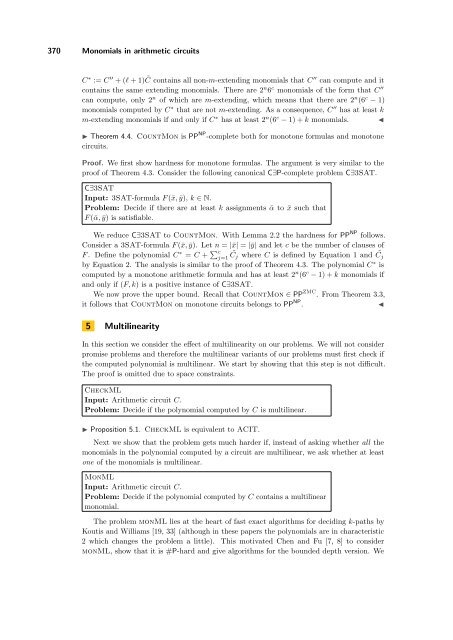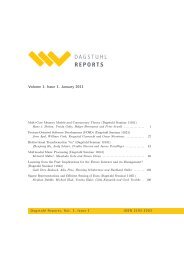Complete problems in the counting hierarchy - DROPS - Schloss ...
Complete problems in the counting hierarchy - DROPS - Schloss ...
Complete problems in the counting hierarchy - DROPS - Schloss ...
You also want an ePaper? Increase the reach of your titles
YUMPU automatically turns print PDFs into web optimized ePapers that Google loves.
370 Monomials <strong>in</strong> arithmetic circuits<br />
C ∗ := C ′′ + (ℓ + 1) ˜ C conta<strong>in</strong>s all non-m-extend<strong>in</strong>g monomials that C ′′ can compute and it<br />
conta<strong>in</strong>s <strong>the</strong> same extend<strong>in</strong>g monomials. There are 2 n 6 c monomials of <strong>the</strong> form that C ′′<br />
can compute, only 2 n of which are m-extend<strong>in</strong>g, which means that <strong>the</strong>re are 2 n (6 c − 1)<br />
monomials computed by C ∗ that are not m-extend<strong>in</strong>g. As a consequence, C ′′ has at least k<br />
m-extend<strong>in</strong>g monomials if and only if C ∗ has at least 2 n (6 c − 1) + k monomials. ◭<br />
◮ Theorem 4.4. CountMon is PP NP -complete both for monotone formulas and monotone<br />
circuits.<br />
Proof. We first show hardness for monotone formulas. The argument is very similar to <strong>the</strong><br />
proof of Theorem 4.3. Consider <strong>the</strong> follow<strong>in</strong>g canonical C∃P-complete problem C∃3SAT.<br />
C∃3SAT<br />
Input: 3SAT-formula F (¯x, ¯y), k ∈ N.<br />
Problem: Decide if <strong>the</strong>re are at least k assignments ¯α to ¯x such that<br />
F (¯α, ¯y) is satisfiable.<br />
We reduce C∃3SAT to CountMon. With Lemma 2.2 <strong>the</strong> hardness for PP NP follows.<br />
Consider a 3SAT-formula F (¯x, ¯y). Let n = |¯x| = |¯y| and let c be <strong>the</strong> number of clauses of<br />
F . Def<strong>in</strong>e <strong>the</strong> polynomial C∗ = C + �c j=1 ˜ Cj where C is def<strong>in</strong>ed by Equation 1 and ˜ Cj<br />
by Equation 2. The analysis is similar to <strong>the</strong> proof of Theorem 4.3. The polynomial C∗ is<br />
computed by a monotone arithmetic formula and has at least 2n (6c − 1) + k monomials if<br />
and only if (F, k) is a positive <strong>in</strong>stance of C∃3SAT.<br />
We now prove <strong>the</strong> upper bound. Recall that CountMon ∈ PP ZMC . From Theorem 3.3,<br />
it follows that CountMon on monotone circuits belongs to PP NP . ◭<br />
5 Multil<strong>in</strong>earity<br />
In this section we consider <strong>the</strong> effect of multil<strong>in</strong>earity on our <strong>problems</strong>. We will not consider<br />
promise <strong>problems</strong> and <strong>the</strong>refore <strong>the</strong> multil<strong>in</strong>ear variants of our <strong>problems</strong> must first check if<br />
<strong>the</strong> computed polynomial is multil<strong>in</strong>ear. We start by show<strong>in</strong>g that this step is not difficult.<br />
The proof is omitted due to space constra<strong>in</strong>ts.<br />
CheckML<br />
Input: Arithmetic circuit C.<br />
Problem: Decide if <strong>the</strong> polynomial computed by C is multil<strong>in</strong>ear.<br />
◮ Proposition 5.1. CheckML is equivalent to ACIT.<br />
Next we show that <strong>the</strong> problem gets much harder if, <strong>in</strong>stead of ask<strong>in</strong>g whe<strong>the</strong>r all <strong>the</strong><br />
monomials <strong>in</strong> <strong>the</strong> polynomial computed by a circuit are multil<strong>in</strong>ear, we ask whe<strong>the</strong>r at least<br />
one of <strong>the</strong> monomials is multil<strong>in</strong>ear.<br />
MonML<br />
Input: Arithmetic circuit C.<br />
Problem: Decide if <strong>the</strong> polynomial computed by C conta<strong>in</strong>s a multil<strong>in</strong>ear<br />
monomial.<br />
The problem monML lies at <strong>the</strong> heart of fast exact algorithms for decid<strong>in</strong>g k-paths by<br />
Koutis and Williams [19, 33] (although <strong>in</strong> <strong>the</strong>se papers <strong>the</strong> polynomials are <strong>in</strong> characteristic<br />
2 which changes <strong>the</strong> problem a little). This motivated Chen and Fu [7, 8] to consider<br />
monML, show that it is #P-hard and give algorithms for <strong>the</strong> bounded depth version. We













